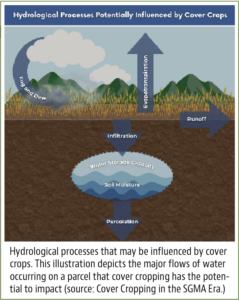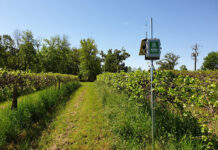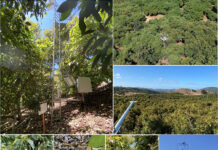Growers in the west are facing more and more pressure to account for their water use. On May 13, Sustainable Conservation (SusCon) released a report entitled Cover Cropping in the SGMA Era, summarizing two years of convenings held by SusCon with over 100 scientists, crop advisers and other agricultural professionals and stakeholders. The report distills research and working knowledge of the aspects of cover cropping impacts upon soil water budgets in the context of the Sustainable Groundwater Management Act (SGMA) and associated Groundwater Sustainability Agencies (GSAs). Specifically, the report provides three areas of information derived from hours of convenings and interviews with GSA representatives:
1. A research summary of cover crop impacts to the water cycle, focused on California, Mediterranean and semi-arid climates
2. An investigation about impacts SGMA and GSA management may have on the use of cover crops
3. Recommendations for statewide water planners regarding the use of cover crops as a Climate-Smart Practice
Cover Crops Use and Management in California
Cover crops are a non-cash crop grown for multiple benefits. Cover cropping is generally recognized as an option for growers to fill a void and armor the soil between cropping seasons. The USDA Natural Resources Conservation Service (NRCS) incentivizes growers to grow cover crops across the nation, and the CDFA Healthy Soils Program incentivizes growers to grow cover crops in California.
In addition to soil armoring, cover crops are recognized to provide a wide array of ecological services, that include improved water infiltration, water quality protection, erosion control, weed suppression, pollinator support and nutrient cycling to name a few. Cover cropping as a conservation practice is also one of USDA’s climate-smart agricultural practices because the practice also sequesters carbon, which improves soil health by feeding microbial populations and improves climate resiliency by the simple fact it holds soil together with its roots. In California’s Mediterranean climate, where most of the annual precipitation occurs between the months of November and March, cover crops are generally planted in the fall and rely on rainfall to grow. They are terminated in spring using various methods and at different times, depending on the crop, field conditions, operation schedules and grower’s objectives for using the cover crop in the first place.
Prior to World War II, cover cropping was a common practice, especially the use of leguminous cover crops to provide nitrogen for crop production. In the 1950s and beyond, an increased prevalence of commercial fertilizers coincided with a decrease in use of cover crops. Over the past 30 to 40 years, cover cropping interest grew, paralleling society’s growing interest in agricultural sustainability, organic farming, the environment and soil health.
Prior to the widespread interest in soil health in California, it was not unheard of for crop advisors to discourage cover cropping due to concerns for water competition with the cash crop. Following SGMA, a similar and more serious controversy evolved regarding the potential impact of cover crops upon groundwater supply.

Sustainable Groundwater Management Act and Cover Crop Water Use
Amid one of the most severe droughts in Californian history (2012-14), SGMA was instituted by the state to build a framework of GSAs to protect aquifers from overdraft using local jurisdiction. The drought accelerated groundwater use, causing groundwater in parts of the state to drop 50 to 100 feet below previous historical lows.
Several years ago, the agricultural community heard stories about growers avoiding cover cropping due to the fear of being penalized by their local GSA for allowing cover crops to grow on their farms. Further investigation by SusCon and other stakeholders showed cover crops may be unintentionally discouraged by GSAs because of the water budget accounting methods used that. at times, incentivized the maintenance of bare ground. Methods used for water accounting, such as satellite imagery, were based upon the assumption that cover crops have an evapotranspiration (ET) value that negatively impacts groundwater recharge. Research on cover crop water use increased in 2016, when a group of UC Davis researchers began to investigate the topic more closely to try to answer some unknowns about the potential of cover crops to impact the soil water balance and aquifer recharge.
It is an undeniable truth that winter cover crops use water for establishment and growth until termination in spring. How much water they use is what has shown difficult to answer precisely, and this value changes based on many factors, such as soil texture, climate, time of year, ground cover, the cover crop being grown and timing of cover crop termination. Recent studies as outlined in the report show winter cover cropping can use between 1 and 2 inches for establishment, which in some cases falls within a “margin of error” for annual irrigation rates for cropping systems (Smither-Kopperl pers. comm. 2024, DeVincentis 2023).
In some locations in California, growers do not plant cover crops because the climate and water supply will support multiple cash crops in a single year. With climate change, these options may become more limited, and growers and agronomists will have to seek out other opportunities for maintaining soil health between growing cycles. I recently heard about innovators exploring the use of “precision cover cropping,” whereby plantings are in narrow bands to either coincide with a cash crop’s rooting area or to address specific soil health and soil quality issues, like soil crusting and compaction.
Cover crop adoption rates in California and other states have hovered around 0% to 5% for years. In the SusCon report, cover crops include prescribed planting of cover crops (native and non-native) and volunteer groundcover (weeds). Many conservation entities encourage prescribed planting of cover crops to achieve and maximize multiple benefits and ecological services. Nevertheless, whether they’re intentionally planted or not, living ground cover in the fields during off seasons protects the soil.
Ironically, at times, the discussion of whether cover crops compete for water with the following crop seemed to be isolated from the discussion of the many ecological services they provide, namely increased water infiltration and decreased runoff, the two most pronounced hydrological services cover crops can provide.

Summary of Findings
The SusCon report is an in-depth account of the current state of knowledge for soil water impacts of cover crops in Mediterranean climate regimes. Key findings outlined in the report were:
• Cover cropping improves the soil ecology and water cycling and provides other benefits.
• Impact of cover crops on water budgets is highly variable and depends on an assortment of factors, not limited to climate, soils and management.
• Cover cropping has shown to have a negligible impact on ET compared to bare ground in perennial and annual systems in Mediterranean climates.
• Wintertime, rain-fed cover cropping does not significantly increase water losses compared to bare ground in the winter months.
• California-based research literature showed the dominant water-balance benefits of cover cropping are increased water infiltration into the soil and the reduction of runoff, frequently ≥40% for both pathways.
From its research, Suscon developed five core recommendations to support SGMA implementation for sustainable water use in California:
1. Create a coordinated research approach to improve understanding of the impact of cover crops on net water balances.
2. Identify and address knowledge gaps that would allow GSAs to permit integration of cover cropping within their jurisdictions.
3. Support GSAs with up-to-date scientific information and guidance related to satellite ET, flow meter data and consumptive groundwater.
4. Improve data acquisition processes for key ET data and high-resolution data essential to GSA management, which would improve the quantity and quality of the data.
5. Provide funding to improve technical support for GSA that support research and guidance documents related to key ET data inputs.
This report gives me great confidence that water managers, growers, crop advisors, scientists and stakeholders can find ways to effectively use cover crops where it makes sense to do so. We can design the cover crop management strategies to accommodate multiple environmental benefits and match strategies to location and geography when we find cover crops appropriate to use. These designed benefits can and will include water conservation.
Resources
California Dept. of Water Resources, (February 2015) California’s Most Significant Droughts: Comparing Historical and Recent Conditions https://cawaterlibrary.net/wp-content/uploads/2017/05/CalSignficantDroughts_v10_int.pdf
DeVincentis, A., Solis, S. S., Rice, S., Zaccaria, D., Snyder, R., Maskey, M., Gomes, A., Gaudin, A., & Mitchell, J. (2022). Impacts of winter cover cropping on soil moisture and evapotranspiration in California’s specialty crop fields may be minimal during winter months. California Agriculture, 76(1), 37–45.
Ingels, C., Horn, M. V., Bugg, R., & Miller, P. R. (1994). Selecting the right cover crop gives multiple benefits. California Agriculture, 48(5), 43–48USDA ERS. (2023). State Fact Sheets: California [dataset]. https://data.ers.usda.gov/reports.aspx?StateFIPS=06&StateName=California&ID=17854
Kratt (February 2024) “Cover Crop Use in California and Measurable Outcomes” Progressive Crop Consultant
Lloyd, Margaret (May 2023) The Costs and Benefits of Growing a Cover Crop in an Annual Rotation in the Lower Sacramento Valley Progressive Crop Consultant
Mitchell et. al; (2023) Water Related Impacts of Cover Cropping. YouTube Video. https://www.youtube.com/watch?v=mTNLx6LzEt0
Sustainable Conservation (May 2024) Report: Cover Cropping in the SGMA Era. https://suscon.org/blog/2024/05/ccrop-report-release/
USDA ERS, Wallender et al. (February 2021) Economic Information Bulletin Number 222 Cover Crop Trends, Programs, and Practices in the United States https://www.ers.usda.gov/webdocs/publications/100551/eib-222.pdf
Wyant, Karl (March 2023) “The Agronomy of Water” Progressive Crop Consultant



















